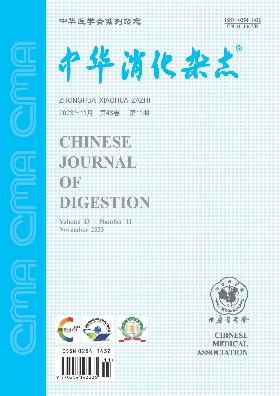Results of 24-hour esophageal impedance-pH monitoring in 141 patients with gastroesophageal reflux disease
引用次数: 0
Abstract
Objective To analyze the relationship between body type, age, gender, esophageal motility function, lower esophageal sphincter pressure (LESP) and clinical classification and type of reflux contents of patients with gastroesophageal reflux disease (GERD). Methods From September 2015 to July 2016, at Beijing Tongren Hospital of China Capital Medical University, the results of 24-hour esophageal impedance-pH monitoring of 141 patients with GERD were retrospectively analyzed. The differences of reflux contents were compared in patients with GERD among different body type, age, gender, esophageal motility function, LESP and clinical classification. Mann-Whitney test was performed for comparison between groups. Results Acid reflux was more common in obese patients (body mass index more than 23.9 kg/m2) compared with patients with normal body type (body mass index from 18.5 to 23.9 kg/m2) (18.5, 7.0 to 45.3 vs. 10.0, 2.0 to 32.0), and the difference was statistically significant (Z=-2.320, P=0.020). Patients under 65 years old had more numbers of weak acid reflux, non-acid reflux and gas reflux than patients over 65 years old (58.5, 32.8 to 95.0 vs. 40.0, 24.0 to 71.0; 19.5, 6.0 to 47.5 vs. 8.0, 3.0 to 19.0; 46.0, 23.8 to 79.3 vs. 35.0, 11.0 to 56.0), and the differences were statistically significant (Z=-2.690, -3.286 and -2.091, all P 0.05). Patients with reflux esophagitis(RE)and /or Barrett′s esophagus (BE) had more weak acid reflux, non-acid reflux and gas reflux compared with patients with non-erosive reflux disease (NERD) (61.0, 31.3 to 102.5 vs. 44.0, 24.5 to 66.5; 18.0, 8.0 to 36.5 vs. 8.0, 2.0 to 22.0; 49.5, 27.5 to 86.5 vs. 26.0, 11.0 to 47.0), and the differences were statistically significant (Z=-2.585, -2.942 and -3.278, all P<0.05). Patients with lower esophageal sphincter (LES) relaxation were more likely to have weak acid reflux than patients with normal LES function (57.0, 32.3 to 87.0 vs. 40.0, 21.0 to 73.0), the difference was statistically significant (Z=-2.065, P=0.039). Conclusion Body type, age, gender, LESP and clinical classification are related to type of reflux contents in GERD patients, while esophageal peristalsis is irrelevant. Key words: Gastroesophageal reflux; 24-hour esophageal impedance pH monitoring; Patterns of reflux episodes141例胃食管反流病患者24小时食管阻抗- ph监测结果
目的分析胃食管反流病(GERD)患者的体型、年龄、性别、食管运动功能、食管下括约肌压力(LESP)与临床分型及反流内容物类型的关系。方法回顾性分析2015年9月至2016年7月中国首都医科大学附属北京同仁医院141例胃食管反流患者24小时食管阻抗- ph监测结果。比较不同体型、年龄、性别、食管运动功能、LESP及临床分型的GERD患者反流内容的差异。采用Mann-Whitney检验进行组间比较。结果肥胖患者(体质量指数> 23.9 kg/m2)与正常体质患者(体质量指数18.5 ~ 23.9 kg/m2)相比(18.5、7.0 ~ 45.3 vs. 10.0、2.0 ~ 32.0)胃酸反流发生率较高,差异有统计学意义(Z=-2.320, P=0.020)。65岁以下患者的弱酸反流、非酸反流和气体反流次数多于65岁以上患者(58.5、32.8 ~ 95.0 vs. 40.0、24.0 ~ 71.0;19.5, 6.0到47.5 vs. 8.0, 3.0到19.0;46.0、23.8 ~ 79.3 vs. 35.0、11.0 ~ 56.0),差异有统计学意义(Z=-2.690、-3.286、-2.091,P均为0.05)。与非糜烂性反流病(NERD)患者相比,反流性食管炎(RE)和/或巴雷特食管(BE)患者有更多的弱酸反流、非酸反流和气体反流(61.0,31.3 ~ 102.5 vs. 44.0, 24.5 ~ 66.5;18.0, 8.0至36.5 vs. 8.0, 2.0至22.0;49.5、27.5 ~ 86.5 vs. 26.0、11.0 ~ 47.0),差异有统计学意义(Z=-2.585、-2.942、-3.278,P均<0.05)。食管下括括肌(LES)松弛患者发生弱酸反流的可能性高于LES功能正常患者(57.0、32.3 ~ 87.0 vs. 40.0、21.0 ~ 73.0),差异有统计学意义(Z=-2.065, P=0.039)。结论GERD患者的体型、年龄、性别、LESP及临床分型与反流内容类型相关,与食管蠕动无关。关键词:胃食管反流;24小时食管阻抗pH监测;反流发作模式
本文章由计算机程序翻译,如有差异,请以英文原文为准。
求助全文
约1分钟内获得全文
求助全文

 求助内容:
求助内容: 应助结果提醒方式:
应助结果提醒方式:


